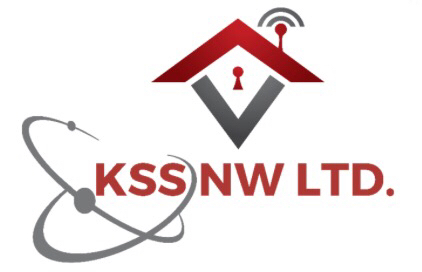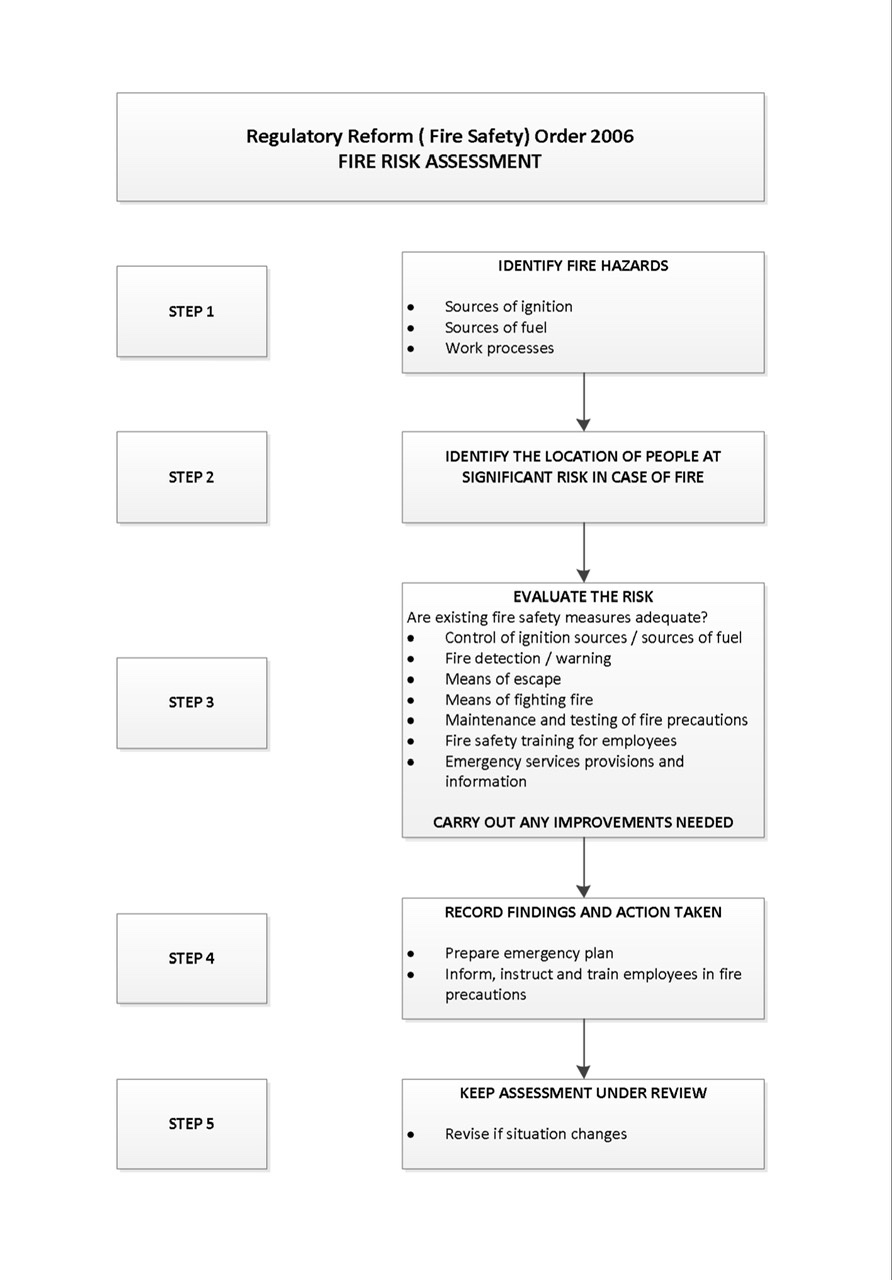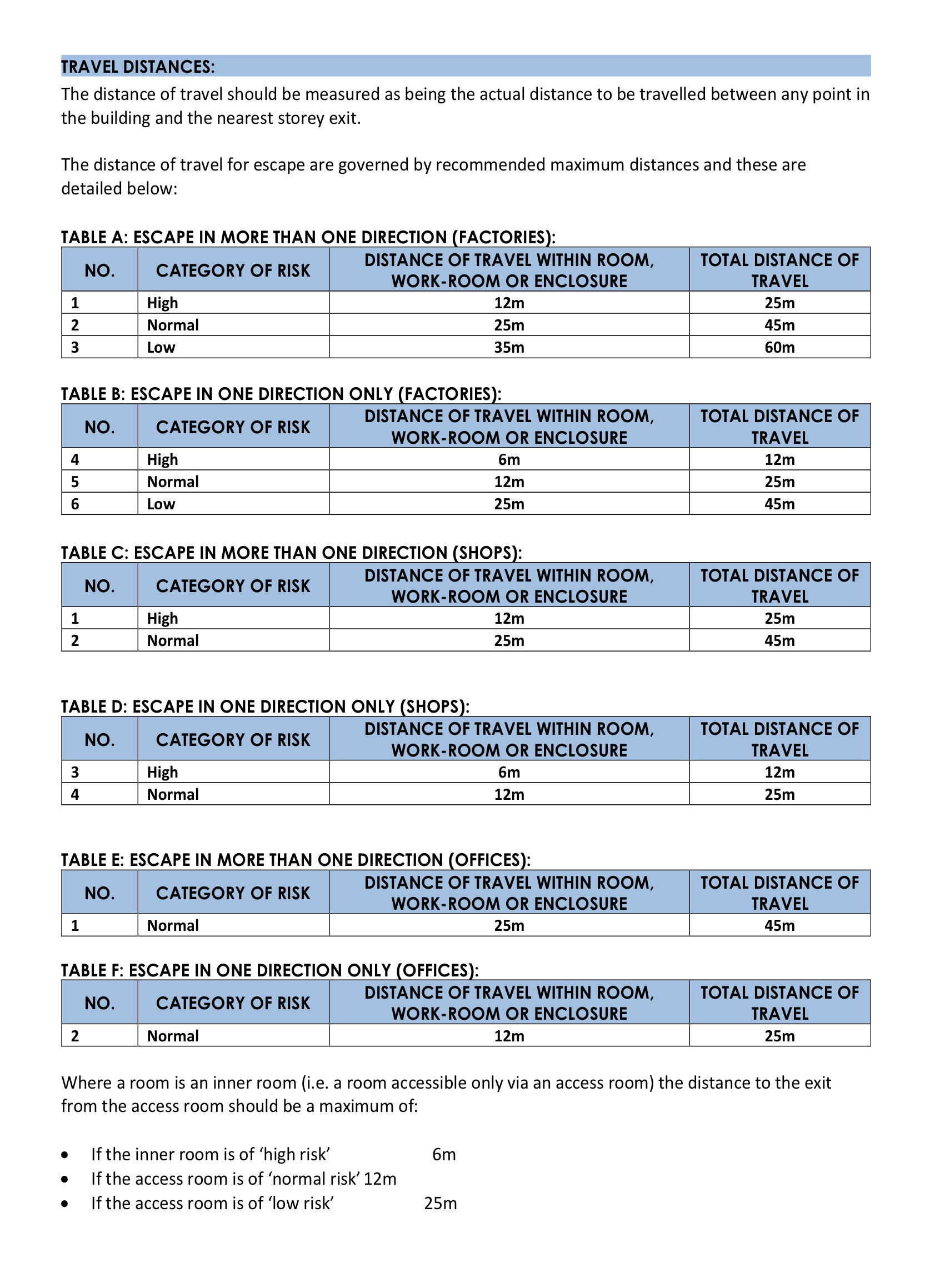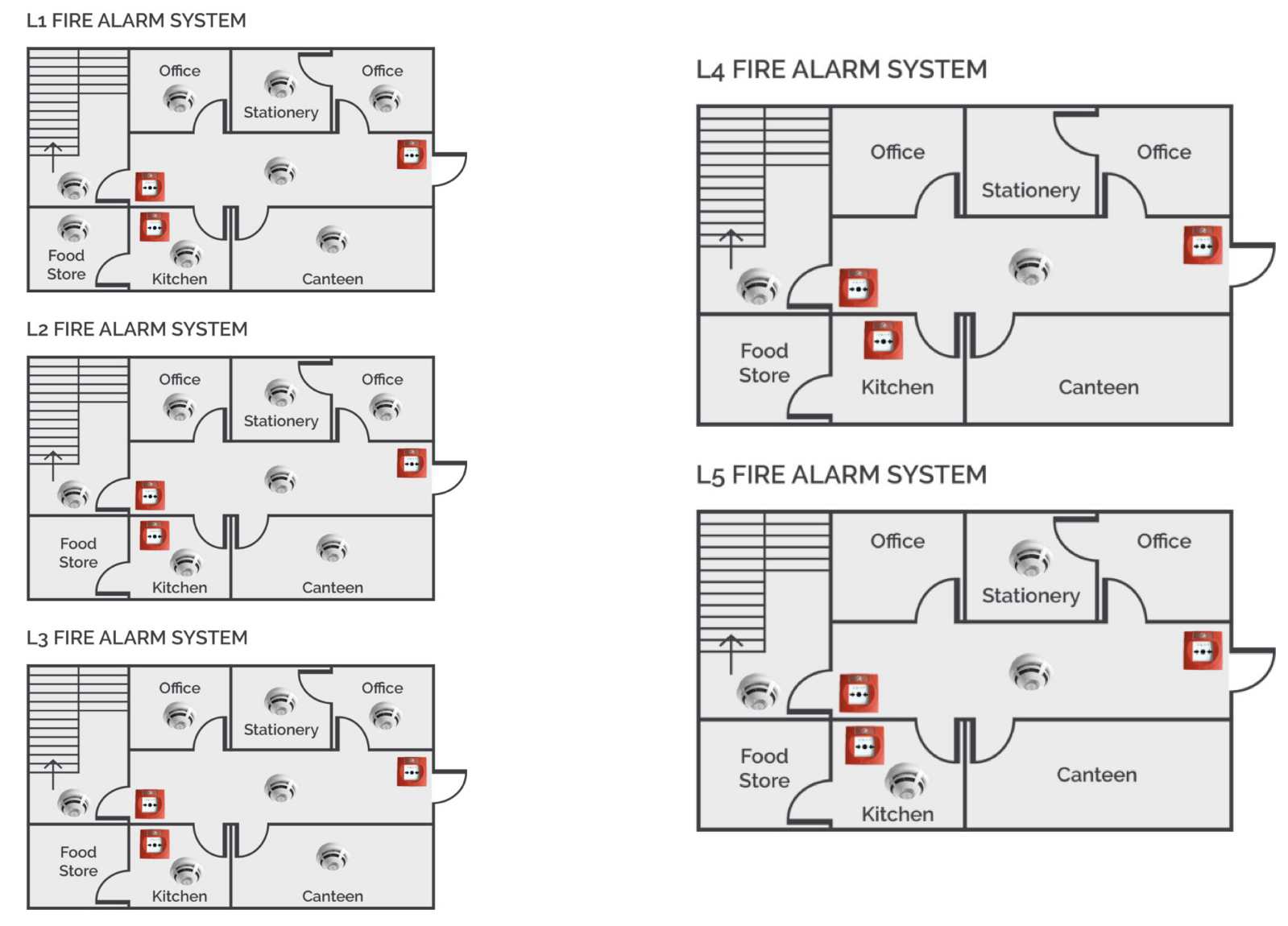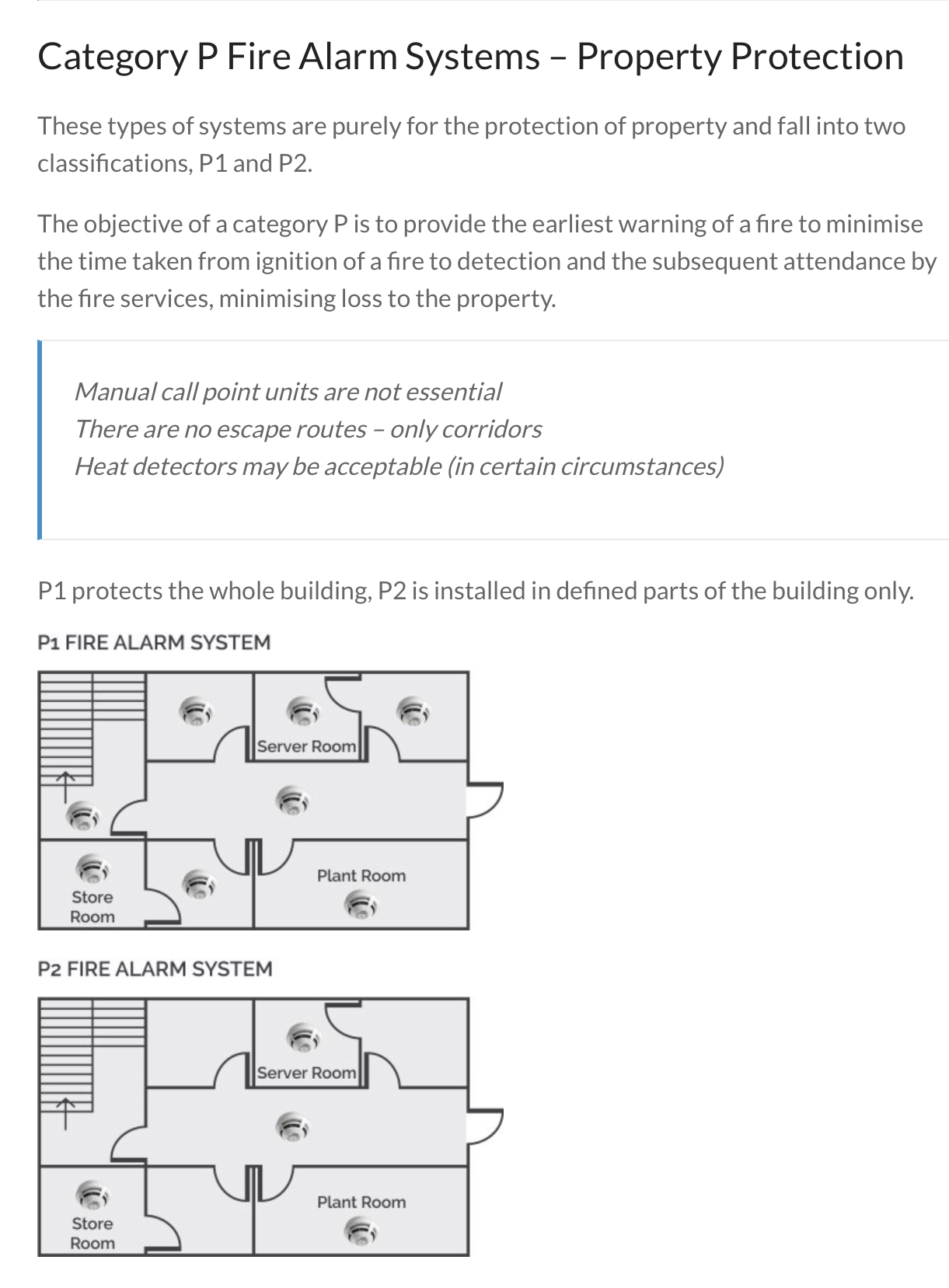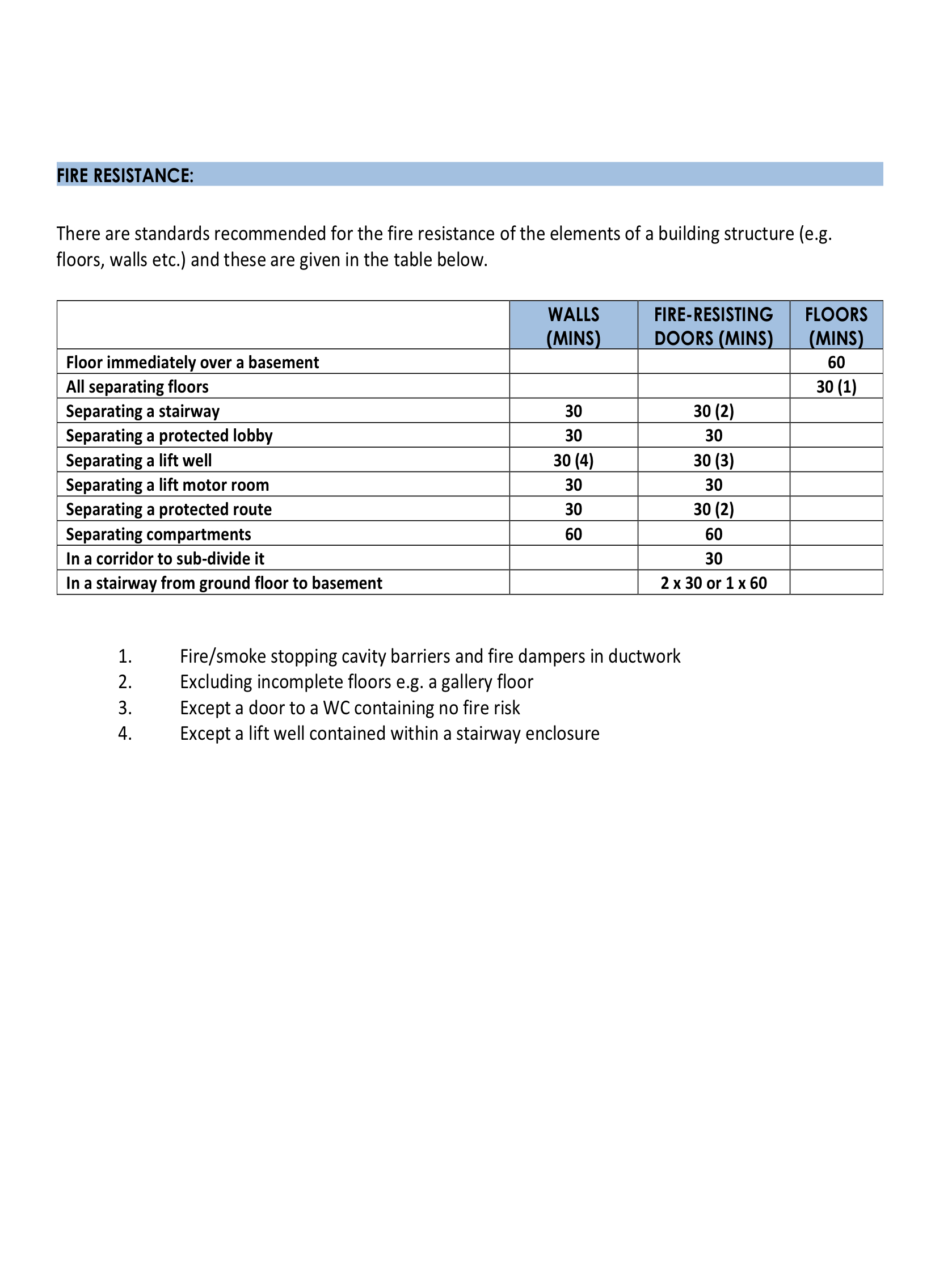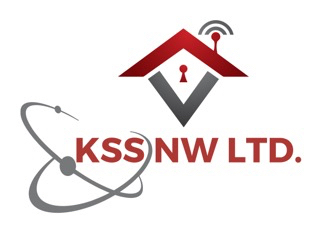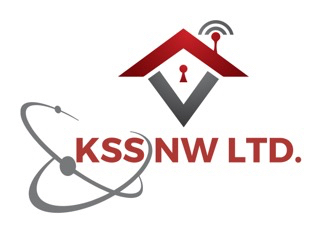Information
Regulator Reform (Fire Safety) Order 2005 Fire Risk Assessment
-
Assessment Type
-
Client Name
-
Site Name
-
Site Number / Ref: if applicable
-
Photo of Site / Building / Premises
-
Responsible person (e.g. employer) or person having control of the premises:
-
Address or premises:
-
Site Location
-
Assessor:
-
Date of fire risk assessment:
-
Date of pervious fire risk assessment:
-
Suggested date for review(1:
-
The purpose of this report is to provide an assessment of the risk to life from fire in these premises, and, where appropriate, to make recommendations to ensure compliance with fire safety legislation. The report does not address the risk to property or business continuity from fire.
-
This fire risk assessment should be reviewed by a competent person by the date indicated above or at such earlier time as there is reason to suspect hat it is no longer valid, or if there has been a significant change in the matters to which it relates, or if a fire ocurs.
-
-
-
Category L Fire Alarm Systems – Life Protection
Life protection systems can be divided into various categories, L1, L2, L3, L4, L5.
L1 provides for Automatic Fire Detection (AFD) to be installed into all areas of a building.
L2 provides Automatic Fire Detection (AFD) as defined in L3 as well as high risk or hazardous areas. Examples of this could be Kitchens, boiler rooms, sleeping risk, storerooms if not fire resistant or if smoke could affect escape routes.
L3 Automatic Fire Detection (AFD) with smoke detection should be installed on escape routes with detection in rooms opening onto escape routes.
L4 provides Automatic Fire Detection (AFD) within escape routes only.
L5 is installed in building with a specific risk that has been identified. An example of this would be if there was an area of high risk that requires detection the category would be L5/M. -
-
-
Fire Risk Assessment Terms and Conditions:
It is agreed that to enable a thorough inspection and assessment, the Fire Risk Assessor will be allowed open and free access to any sites and any areas within those sites covered by the contract.
It is the responsibility of the Customer to ensure that all relevant personnel are fully aware of the Fire Risk Assessors visit and that the Fire Risk Assessor or others working on behalf of the Assessing Company are not hindered in any way in the carrying out of their duties
The Fire Risk Assessor will use all best endeavours to advise the Customer as to the status, regulations and systems of work appropriate to the Customer’s fire risk assessment so as to assist the Customer to fulfil their duties in accordance with such statutes, regulations, standards and such systems of work which may be applicable to the Customers specific industry.
The Fire Risk Assessment will be based on a sample of the working environment as identified at the time of the Fire Risk Assessors visit. It is possible that this sample may not be entirely representative of all aspects of the working environment.
Whilst the Fire Risk Assessor will use best endeavours to identify those matters which are considered unacceptable to current fire safety regulations and which have been observed during the inspection, KSS NW Ltd cannot be held responsible for non-compliance with relevant statutes, regulations and standards or systems of work or for failing to observe industry fire and safety working practices whether such non-compliance or failure is by the Customer, it’s servants, agents, contractors or sub-contractors.
The Fire Risk Assessor should be notified of any visit or intended visit to be made to the premises by a Fire Enforcement Authority or Insurance Fire assessor prior to carrying out the fire risk assessment.
The Fire Risk Assessment will be based on a visual inspection or the working environment, no testing of the luminance levels or sounders, of the design or the HVAC system will be carried out.
The Fire Risk Assessment should be reviewed by a competent person by the date indicated or at such earlier time as there is a reason to suspect that the Fire Risk Assessment is no longer valid, or if there has been a significant change in matters to which it relates, or if a fire occurs
If requirements or recommendations are made by a Fire Enforcement Authority, Insurance Risk Assessor or KSS NW Ltd, it is recommended that Customer carry out these requirements or recommendations as soon as is reasonably practicable. Notification of completion of relevant parts should be made to KSS NW Ltd in writing.
The Fire Risk Assessor must be immediately notified at the time of the visit of any recommendation or requirements made by the Fire Enforcement Authority or Insurance Risk Assessor. It is the Customer’s responsibility to comply with such recommendations or requirements.
When fire hazards are identified which in the opinion of the Fire Risk Assessor requires the advice of a particular specialist, KSS NW Ltd will notify the Customer accordingly and will indicate where in its opinion such advice and service may be obtained. It shall be the Customer’s decision whether or not to use the particular specialist. The cost of such specialist advice shall at all times remain the responsibility of the Customer.
KSS NW Ltd limits its liability for any loss, damage or injury (or consequential or indirect loss) arising form the performance of, or failure by, KSS NW Ltd to perform any of its duties (whether or not such loss damage or injury or consequential or indirect loss be due to the negligence of KSS NW Ltd, its servants or agents or to any other cause whatsoever) to that determined by our Insurance Policy. -
Fire Assessor - Conditions & Disclaimer
Be fully aware that:-
1. The assessor as no control over management of the premises, once the assessment has been completed
2. The assessor is not responsible for the failure to implement significant findings and action points.
3. The assessor has no control over the site staffing levels
4. The assessment may be compiled, without having had full access to the premises, without testing the fire protection qualities or separation. In such circumstances, the assessment findings will be based on visual observations and without appropriate surveys being carried out.
5. The assessor / assessment is not responsible should there be any subsequent changes to the premises, subsequent faults in equipment or deterioration in the premises and testing protocols.
6. The assessor / assessment / KSS NW LTD, are not responsible for the ongoing management and running of the site / premises and the decision to allow the premises to be used or continued to be used for its present purpose, remains with the responsible person(s)
7. At no point does the assessor / assessment / KSS NW LTD, agree to adopt or accept any responsibility for the control of all or any part of the premises. At all times this will remain the full responsibility of the “Responsible Person(s) and will remain as such.
8. The report refers to the areas of the premises accessible at the time of the assessment . Structures and features hidden from view, such as ceiling voids; service ducts; etc. May not have been subject to the assessment and the “Responsible Person(s) has a duty to ensure these areas are safe. During the assessment, it has been assumed that any fire detection; fire fighting; emergency lighting, etc have been supplied, installed and maintained to current British and European standards and the premises constructed with regards to building control and as detailed under the current building regulations.
9. All findings and recommendations contained in this report, are based on evidence and visual observations, seen at the time
General Information
1. The Premises
-
1.1 Number of Floors
-
1.2 Approximate floor area:
-
If known Approx Floor area m2 or ft2
-
Number of Fire Escapes available
-
1.3 Brief details of construction:
-
1.4 Use of premises
-
More Specifically
2. The Occupants
-
2.2 Approximate number of employees at any one time:
-
2.3 Maximum number of members of public at any one time:
-
2.4 Associated times/hours of occupation:
3. Occupants Especially at Risk from Fire
-
3.1 Sleeping occupants:
-
3.2 Disabled occupants:
-
3.3 Occupants in remote areas and lone workers:
-
3.4 Young persons:
-
3.5 Others:
4. Fire Loss Experience / Enforcement
-
4.1 Previous History Of Fire (Last 12 Months)
Incident
-
Floor
-
Room/ Area
-
Reason for Incident
-
Person Injured as a Result of Fire
-
Additional Information
5. Other Relevant Information
-
5.1 Previous Fire Risk Assessments
Fire Risk Assessment
-
Consultant Name
-
Company Name
-
Date of Fire Risk Assessment
-
Significant Findings Addressed?
Finding
-
Comment:
-
Are there any residential properties in or attached to the building?
-
Is there a prohibition notice in force? (If Yes, give details)
-
Is there an alteration notice in force? (If yes, give details
-
Is there any enforcement notice in force ? (If yes, give details)
Fire Hazards and their Elimination or Control
7. Electrical Sources of Ignition
-
7.1 Reasonable measures taken to prevent fires of electrical origin?
-
7.2 More specifically:
-
Fixed installation periodically inspected and tested?
-
Portable appliance periodically tested?
-
Suitable limitation of trailing leads and adapters?
8. Smoking
-
8.1 Reasonable measures taken to prevent fires as a result of smoking?
-
8.2 More specifically:
-
Smoking prohibited on the premises?
-
Suitable arrangement for those who wish to smoke?
-
This policy appeared to be in place at time of inspection?
9. Arson
-
9.1 Does basic security against arson by outsiders appear reasonable?
-
9.2 Is there an absence of unnecessary fire load in close proximity to the premises or available for ignition by outsiders?
10. Portable Heaters and Heating Installations
-
10.1 Is the use of portable heaters avoided as far as practicable?
-
10.2 If portable heaters are used:
-
Is the use of the more hazardous type (e.g. Radiant bar fires or lpg appliances) avoided?
-
Are suitable measures taken to minimise the hazard of ignition of combustible materials.
-
10.3 Are fixed heating installations subject to regular maintenance?
11. Cooking
-
11.1 Reasonable measures taken to prevent fires as a result of cooking?
-
11.2 More specifically:
-
Suitable extinguishing appliances available?
-
11.3 What type of cooking equipment is available or used?
- Electric Oven
- Gas Oven
- Microwave
- Kettle
12. Lightning
-
12.1 Does the premises have lightning protection system?
13. Housekeeping
-
13.1 Is the standard of housekeeping adequate?
-
13.2 More specifically:
-
Combustible materials appear to be separated from ignition sources?
-
Avoidance of unnecessary accumulation of combustible materials?
-
Appropriate storage of hazardous materials?
-
Avoidance of inappropriate storage of combustible materials?
14. Hazards Introduced by Outside Contractors and Building Works
-
14.1 Are fire safety conditions imposed on outside contractors?
-
14.2 Is there satisfactry control over works carried out on the premises by outside contractors (including "hot works" permits)?
-
14.3 If there are in-house matinenance personel, are suitable precautions taken during "hot work", including the use of "hot work" permits?
15. Dangerous Substances
-
15.1 Are the general fire precautions adequate to address the hazards associated with dangerous substances used or stored within the premises?
-
15.2 If 15.1 applies, has a specific risk assessment been carried out as required by the Dangerous Substances and Explosive Atmospheres Regulations 2002?
16. Other significant fire hazards that warrant consideration including process hazards that impact on general fire precautions
-
16.1 Hazards:
-
16.2 Comments and deficiences observed:
Fire Protection Measures
17. Means of Escape from Fire
-
17.1 It is considered that the building is provided with adequate means of escape in case of fire?
-
17.2 More specifically:
-
Satisfactory means for securing exits?
-
Are escape routes clear and unobstructed?
-
Reasonable distances of travel:
-
Suitable protection of escape routes?
-
Suitable fire precautions for all inner rooms?
-
Adequate design of escape routes?
-
Exits easily and immediately openable where necessary?
-
Fire exits open in direction of escape where necessary?
-
Avoidance of sliding or revolving doors as fire exits where necessary?
-
17.3 It is considered that the premises are provided with reasonable arrangements for means of escape for disabled people.
18. Measures to Limit Fire Spread and Development
-
18.1 it is considered that there is:
-
compartmentation of a reasonable standard
-
As far as can reasonably be ascertained, reasonable limitation of linings that might promote fire spread.
-
18.2 As far as can reasonable be ascertained, fire dampers are provided as necessary to protect critical means of escape against passage of fire, smoke and combustion products in the early stages of a fire?
-
Are all fire doors in good condition, to ensure the spread if smoke and fire is contained sufficiently for people to escape?
-
Are all fire doors closed (Not wedged open etc)
-
Are hinges on fire doors secure and intact
-
Are the intumescent strips on fire doors in place and intact, to ensure the fore door retains the fire resisting properties to enable persons to escape safely?
19. Emergency Escape Lighting
-
19.1 Reasonable standard of emergency escape lighting system provided?
20. Fire Safety Signs and Notices
-
20.1 Reasonable standard of fire safety signs and notices?
21. Means of Giving Warning in Case of Fire
-
21.1 Reasonable manually operated electrical fire alarm system provided?
-
Are all call points clear and accessible
-
21.2 Automatic fire detection provided?
- Yes (throughout the premises)
- Yes (part / key areas of premises)
- No
-
21.3 Extent of automatic fire detection generally appropriate for the occupancy and fire risk?
-
21.4 Remote transmission of alarm signals?
22. Manual Fire Extinguishign Appliances
-
22.1 Reasonable provision of portable fire extinguishers?
-
22.3 Are all fire extinguishing appliances readily accessible?
-
22.2 Hose reels provided?
23. Relevant Automatic Fire Extinguishing Systems
-
23.1 Type of system:
-
23.2 Comments:
24. Other Relevant Fixed Systems and Equipment
-
24.1 Type of fixed system:
-
24.2 Comments:
-
24.3 Suitable provision of fire-fighters switch(es) for high voltage - Isolation switches clearly signed?
Management of Fire Safety
25. Procedures and Arrangements
-
25.4 Appropriate fire procedures in place?
-
More specifically:
-
Are procedures in the event of fire appropriate and properly documented?
-
Are there suitable arrangements for summoning <br>the fire and rescue service?
-
Are there suitable arrangements for ensuring that the premises have been evacuated?
-
Are there adequate procedures for evacuation of any disabled people who are likely to be present?
-
Persons nominated and trained to assist with evacuation, including evacuation of disabled people?
-
Routine in-house inspections of fire precautions (e.g. in the course of health and safety inspections)?
-
Is there a suitable fire assembly point(s)?
-
Competent person(s) appointed to assist in undetaking preventive and protective measures (i.e. relevant general fire precautions)?
-
Is there a suitable record of the fire safety arrangements?
26. Traninig and Drills
-
26.1 Are all staff given adequate fire safety instruction and training on induction?
-
26.3 Does all staff training provide information, instruction or training on the following:
-
Fire risks in the premises?
-
26.2 Are all staff given adequate periodic “refresher training” at suitable intervals?
-
The fire safety measures on the premises?
-
Action in the event of fire?
-
Action on hearing the fire alarm signal?
-
Method of operation of manual call points?
-
Means for summoning the fire and rescue service?
-
Location and use of fire extinguishers?
-
26.5 Are fire drills carried out at appropriate intervals?
-
26.6 When the employees of another employer work in the premises:
-
Is their employer given appropriate information (e.g. on fire risks and general fire precautions)?
-
Is it ensured that the employees are provided with adequate instructions and information?
27. Testing and Maintenance
-
27.1 Adequate maintenance of premises?
-
27.2 Weekly testing of fire detection and alarm system?
-
27.2.1 Have 6 monthly testing / planned maintenance of Fire Alarm been conducted?
-
27.3 Monthly testing of emergency escape lighting?
-
27.3.2 Annual testing / planned maintenance of Emergency Lighting?
-
27.4 Annual maintenance of fire extinguishing appliances?
-
27.5 Periodic inspection of external escape staircases and gangways?
-
27.6 Six-monthly inspection and annual testing of rising <br>mains?
-
27.7 Weekly and monthly testing, six-monthly inspection <br>and annual testing of fire-fighting lifts?
-
27.8 Annual testing and inspection of sprinkler <br>installations?
-
27.8.1 Where sprinkler systems are installed - Are all sprinkler heads clear of obstruction - Required distance is 500mm
-
27.9 Routine checks of final exit doors and/or security <br>fastenings?
-
27.10 Annual inspection and test of lightning protection <br>system?
-
27.11 Are suitable systems in place for reporting and subsequent restoration of safety measures that have fallen below standard?
-
27.12 Other relevant inspections or tests:
-
Is the Fire Alarm system free of faults
-
If any faults identified or showing on alarm panel, have they been reported to Maintenance a Department - record details
28. Records
-
28.1 Appropriate records of:
-
Fire drills?
-
Fire training?
-
Maintenance and testing of other fire protection <br>systems?
-
Emergency escape lighting tests?
-
Fire alarm tests?
Other Comments / Findings
-
Detail any other Comments / Findings
Risk Rating
Risk Rating
Likelihood of Fire
-
Taking into account the fire prevention measures observed at the time of this risk assessment, it is considered that the hazard from fire (likelihood of fire) at these premises is:
-
In this context, a definintion of the above terms is as follows:
Low Unusually low likelihood of fire as a result of negligible potential sources of ignition.
Normal Normal fire hazards (e.g. potential ignition sources) for this type of occupancy, with fire hazards generally subject to appropriate controls (other than minor shortcomings).
High Lack of adequate controls applied to one or more significant fire hazards, such as to result in significant increase in likelihood of fire.
Potential Consequences of Fire
-
In this context, a definition of the above terms is as follows:
Slight Harm Outbreak of fire unlikelt to reult in serious injury or geath of any occupany (other than an occupany sleeping in a room in which a fire occurs).
Moderate Harm Outbreak of fire could foreseeably result in injury (including serious injury) of one or moreoccupants, but it is unlikely to involve multiple fatalities.
Exterme Harm Significant potential for serious injury or death of one or more occuapnts.
Summary of Risk Rating
-
Taking into account the nature of the building and the occupants, as well as the fire protection and procedural arrangements observed at the time of this fire risk assessment, it is considered that the consequences for life safety in the event of fire would be:
-
Accordingly, it is considered that the risk from fire at these premises is:
Action Plan
-
It is considered that the following recommendations should be implemented in order to reduce fire risk to, or maintain it at, the following level:
-
The priority given for each recommendation should be acted upon as follows:
Low Remedy when next refurbishing or next reviewing management policy.
Medium Action required over next 1-6 months
High Act on immediately. -
Recommended Actions:
Action
-
Recommended Action:
-
Priority
-
Action to whom
-
Date action undertaken
Sign Off
-
Conducted by
-
Name of Person in charge of site at time of assessment
